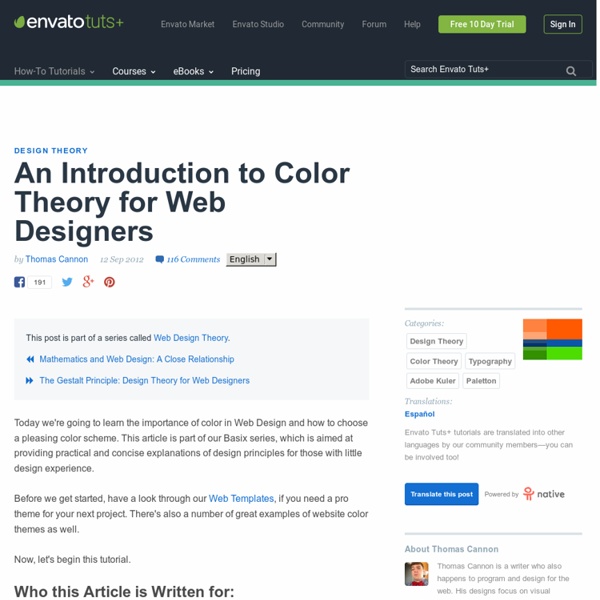



The Ultimate Guide to Basic Color Theory for All Artists Photo: Stock Photos from KRIACHKO OLEKSII/ShutterstockThis post may contain affiliate links. If you make a purchase, My Modern Met may earn an affiliate commission. Please read our disclosure for more info. Color is one of the seven elements of art and one of the first things we learn in school. Used by painters, graphic designers, interior decorators, and anyone working in visual culture, color theory is an essential part of any creative’s toolkit. Scroll down to learn the basics of color theory. History of Color Theory Color wheel by Johann Wolfgang von Goethe, 1809. While it may seem like standard theories about color have always existed, that’s not the case. Initial explorations in color were from a scientific point of view. Later publications, The Theory of Colours by German poet Johann Wolfgang von Goethe and The Law of Simultaneous Color Contrast by French chemist Michel Eugene Chevreul, are considered the founding documents of color theory. Werner’s Nomenclature of Colors, 1821.
How to Evaluate a Website – The Visual Communication Guy: Designing, Writing, and Communication Tips for the Soul A lot goes into making a good website. Whether you use a website for your small business or for your personal portfolio, usability and user-experience matters. You want to make sure that whoever visits your site has a good experience. But how do you know if the website you’ve created or use is effective? You can do a usability test, which requires you to find several prospective users of your website and evaluate how they use your website. Below, I’ve created a checklist below of 41 of the most important (and easy to identify) usability guidelines for evaluating a website. Branding and Homepage #1: PurposeAs simple as it sounds, the most important thing a website needs to communicate is what the website does. #2: PossibilitiesYour visitors will want to know what they can do with the site. #3: Starting PointStrangely enough, some websites are hard to figure out where to start. #4: Visual AppealAesthetics matter! #5: PersonalityYou have total control over your website’s personality.
Eyestrain Eyestrain occurs when your eyes get tired from intense use, such as driving a car for extended periods, reading or working at a computer. Although eyestrain can be annoying, it usually isn't serious and goes away once you rest your eyes. In some cases, signs and symptoms of eyestrain can indicate an underlying eye condition that needs treatment. Although you may not be able to change the nature of your job or all the factors that can cause eyestrain, you can take steps to reduce eyestrain. SymptomsSep. 19, 2012 References Computers and your eyes. HTML Colors Computer Eye Strain Relief Symptoms | Causes | Self help | Tips | Vitamins & supplements | Eye exercisesGlaucoma warning | Conventional Treatment | Laptops | Desktops | For parents Computer eye strain is the #1 eyestrain complaint in the U.S. CVS (computer vision syndrome), more commonly known as computer eye strain is a combination of vision problems noticed during and after working long hours on the computer. OSHA describes it as a repetitive strain disorder affecting 90% of U.S. workers on computers daily. Computers are becoming ubiquitous - they are everywhere and in many forms - all requiring close focused vision. We evolved as hunters and gatherers with vision designed for distance. Staring at your computer for long hours without a break strains your eyes and bodies and results in computer eye strain. Symptoms Causes Too close to computerToo many hours at the computerBlinking lessPoor posturePoor lightingExcessive glare Conventional Treatment Aspirin or pain medicationStronger glasses Related Conditions Studies
Top 10 worst websites you'll wish you hadn't seen - Edit. Remember back in the mid-nineties when websites were a bit of a novelty? They didn’t really serve much of a purpose and, all things considered, were pretty hideous to look at. Common design features were primary colours, flashing letters, poor quality pictures (sometimes hastily Photoshopped together to create a digital collage). As the web has evolved considerably over the last couple of decades, site design and functionality have changed massively, too. Unfortunately (and surprisingly) there are some websites that are still stuck in a bit of a time warp, sporting clunky designs, an overload of information and some pretty poor quality images. Uglytub.com Thinking of replacing your old bath tub? Mrbottles.com Presumably, bottle collecting enthusiasts the world over already know about Mrbottles.com, the online hub for everything you need to know about your bottle collection. Jamilin.com Wholsesalemeatscoventry.com Turn your sound on for the ultimate online experience… Gatesnfences.com
Eyestrain Filed under: Boomer's Health Eyestrain occurs when your eyes get tired from intense use, such as driving a car for extended periods, reading or working at a computer. Although eyestrain can be annoying, it usually isn't serious and goes away once you rest your eyes. In some cases, signs and symptoms of eyestrain can indicate an underlying eye condition that needs treatment. ©1998-2013 Mayo Foundation for Medical Education and Research (MFMER). Please wait while we retrieve the data Ask a Question Want to know more about this article or other health related issues? Chuck Green's curated list of Web Design resources - Ideabook.com These are some of my favorite web design-related resources for graphic designers, marketers, and other creatives. Check back occasionally, the list is always being added to and updated. And when you have some time, try clicking through link-by-link—there are some real treasures here—some that might not jump out at you at first blush—people, products, tools, organizations, and so on, that will help you dig deeper into an area of interest. Most of the links are resources I use personally and/or discuss in posts here on ideabook.com (no one pays for links except for the obvious ads).